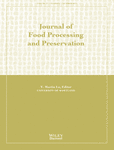EFFECTS OF DIFFERENT COLOR RETENTION METHODS ON THE APPEARANCE OF TILAPIA (OREOCHROMIS NILOTICUS♀ × OREOCHROMIS AUREUS♂) FILLETS
Abstract
ABSTRACT
The effects of different color retention methods on tilapia fillets were studied by evaluating the color of red muscle, extractable myoglobin, content of metmyoglobin and carbon monoxide (CO), and profiles of absorption spectra. The results showed that CO had a significant effect on red muscle coloration. The time spans for the euthanizing and the packaging methods required by red muscle to obtain optimum a* values were 15 and 40 min, respectively. Extractable myoglobin content increased, while metmyoglobin decreased during the initial color retention treatment. Treatment for 15 min using the euthanizing method or for 40 min using the packaging method gave peak values of CO content in the fillets. The a* value was positively correlated with the CO content and myoglobin extractability, but negatively correlated with the metmyoglobin content. A slight redshift in absorption from 410 to 415 nm was observed for red muscle tissue and from 405 to 408 nm for ordinary muscle tissue.
PRACTICAL APPLICATIONS
Red muscle tissue is very susceptible to discoloration. This discoloration is highly undesirable to consumers, thus leading to a lower price than products with a more favorable color. Therefore, several producers are searching for effective ways to solve the problem of discoloration. The euthanizing and packaging methods were assumed to be effective ways to induce the tilapia fillets with bright color. Because of a lack of information on the variation of tilapia fillets during CO treatment, the objective of this study was to compare the effect of two treatments on the color of tilapia muscle tissue.




